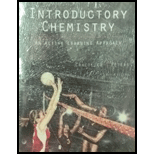
The following information is given for bismuth at
A
Interpretation:
The amount of energy released by the temperature of liquid bismuth is changed from
Concept introduction:
The amount of energy required to change the state of a substance is known as enthalpy. It is the different in the energy of final and initial state of a substance. The negative and positive sign of enthalpy indicates the energy released and energy absorbed, respectively, during the phase change.
Answer to Problem 98E
The amount of energy released by the temperature of liquid bismuth is changed from
Explanation of Solution
Bismuth solidifies at
The amount of energy released when temperature changes from
Where,
•
•
•
•
The specific heat of bismuth is
Substitute the mass, final, initial temperature and specific heat of zinc in equation (1).
The amount of energy required for phase transformation is calculated by the formula shown below.
Where,
•
The heat of fusion of bismuth is
Substitute the mass and heat of fusion in equation (2).
The amount of energy required to change the temperature of bismuth from
Where,
•
•
•
•
The specific heat of bismuth is
Substitute the mass, final, initial temperature and specific heat of bismuth in equation (3).
The amount of energy released by the temperature of liquid bismuth is changed from
Convert
The amount of energy released by the temperature of liquid bismuth is changed from
Want to see more full solutions like this?
Chapter 15 Solutions
Bundle: Introductory Chemistry: An Active Learning Approach, 6th + LMS Integrated for OWLv2, 4 terms (24 months) Printed Access Card
- Food contains three main categories of compounds: carbohydrate, protein, and fat. Arctic explorers often eat a high-fat diet because fats have a high food value. The average food values for carbohydrate, protein, and fat are 4 Cal/g, 4 Cal/g, and 9 Cal/g, respectively. Consider a typical fat to have the chemical formula C18H36O2, glucose (C6H12O6) to be a representative carbohydrate, and the amino acid alanine (C3H6NO2) a building block of proteins. Express the food values given above in kJ/mol.arrow_forwardHow much heat, in kilojoules, is released when a 70.77 g sample of cesium metal is cooled from 729 °C to 347 °C? Potentially Useful Information for cesium: Melting Point (°C) 28.5 Boiling Point (°C) 671 s(s) (J/g·°C) 0.242 s(l) (J/g·°C) 0.177 s(g) (J/g·°C) 0.157 ΔH°fus (kJ/mol) 2.087 ΔH°vap (kJ/mol) 74.4arrow_forwardThe enthalpy of combustion of isooctane (C8H18), one of the many hydrocarbons in gasoline, is 5.45 103 kJ/mol. Calculate the enthalpy change per gram of isooctane and per liter of isooctane (d = 0.688 g/mL).arrow_forward
- The enthalpy of combustion of hard coal averages 35 kJ/g, that of gasoline, 1.28105 kJ/gal. How many kilograms of hard coal provide the same amount of heat as is available from 1.0 gallon of gasoline? Assume that the density of gasoline is 0.692 g/mL (the same as the density of isooctane).arrow_forwardWhat is a driving force? Name two common and important driving forces, and give an example of each. What is entropy? Although the total energy of the universe is constant, is the entropy of the universe constant? What is a spontaneous process?arrow_forwardFrom data in Appendix 4, calculate H, S, and G for each of the following reactions at 25C. a. CH4(g) + 2O2(g) CO2(g) + 2H2O(g) b. 6CO2(g)+6H2O(l)C6H12O6(s)Glucose+6O2(g) c. P4O10(s) + 6H2O(l) 4H3PO4(s) d. HCl(g) + NH3(g) NH4Cl(s)arrow_forward
- The enthalpy change when 1 mol methane (CH4) is burned is 890 kJ. It takes 44.0 kJ to vaporize 1 mol water. What mass of methane must be burned to provide the heat needed to vaporize 1.00 g water?arrow_forwardFor copper, with a Hfus of 209 J/g, how many kilojoules of energy will be absorbed or released when 2.2 moles of liquid copper freezes into a solid?arrow_forwardWhat is the enthalpy of ethanol in Kj/mol: C(graphite) + 2H2+ 1/2 O2 -> CH3OHarrow_forward
- Heating food in the microwave oven is mainly due to the vibration of the molecules of a. fats B. carbohydrates C. Water D. protein :arrow_forward1. An 800g aluminium block cools from 85°C to 30 °C. Calculate the heat capacity, C, of the aluminium block. 2. Construct an energy cycle diagram for potassium fluoride. 3. Determine the lattice energy of potassium fluoride. Enthalpy of atomization of potassium = +89.2kj/mol Enthalpy of atomization of fluorine = +79kj/mol 1st ionization energy of pottasium = +418kj/mol Electron affinity of fluorine = -328kj/mol Enthalpy of formation of potassium fluoride = -561.7kj/molarrow_forwardA 450 g H2O is heated from 10.5oC to 80.0oC. Calculate the amount of heat absorbed (in kilojoules) by H2O. Specific heat of H2O: 4.184 J/g oCarrow_forward

 ChemistryChemistryISBN:9781305957404Author:Steven S. Zumdahl, Susan A. Zumdahl, Donald J. DeCostePublisher:Cengage Learning
ChemistryChemistryISBN:9781305957404Author:Steven S. Zumdahl, Susan A. Zumdahl, Donald J. DeCostePublisher:Cengage Learning Chemistry: An Atoms First ApproachChemistryISBN:9781305079243Author:Steven S. Zumdahl, Susan A. ZumdahlPublisher:Cengage Learning
Chemistry: An Atoms First ApproachChemistryISBN:9781305079243Author:Steven S. Zumdahl, Susan A. ZumdahlPublisher:Cengage Learning Chemistry & Chemical ReactivityChemistryISBN:9781133949640Author:John C. Kotz, Paul M. Treichel, John Townsend, David TreichelPublisher:Cengage Learning
Chemistry & Chemical ReactivityChemistryISBN:9781133949640Author:John C. Kotz, Paul M. Treichel, John Townsend, David TreichelPublisher:Cengage Learning Chemistry & Chemical ReactivityChemistryISBN:9781337399074Author:John C. Kotz, Paul M. Treichel, John Townsend, David TreichelPublisher:Cengage Learning
Chemistry & Chemical ReactivityChemistryISBN:9781337399074Author:John C. Kotz, Paul M. Treichel, John Townsend, David TreichelPublisher:Cengage Learning Introductory Chemistry: A FoundationChemistryISBN:9781337399425Author:Steven S. Zumdahl, Donald J. DeCostePublisher:Cengage Learning
Introductory Chemistry: A FoundationChemistryISBN:9781337399425Author:Steven S. Zumdahl, Donald J. DeCostePublisher:Cengage Learning





